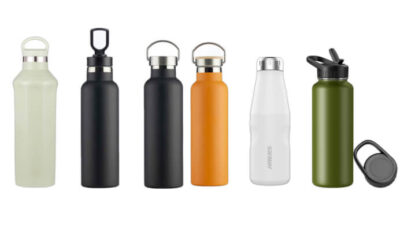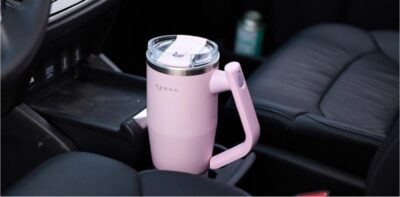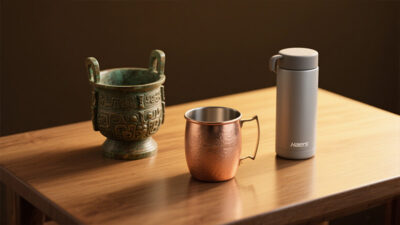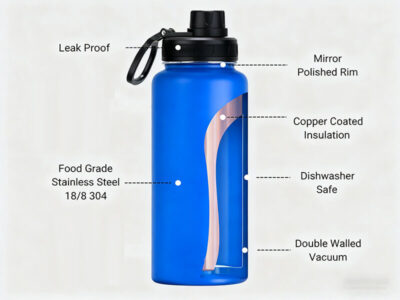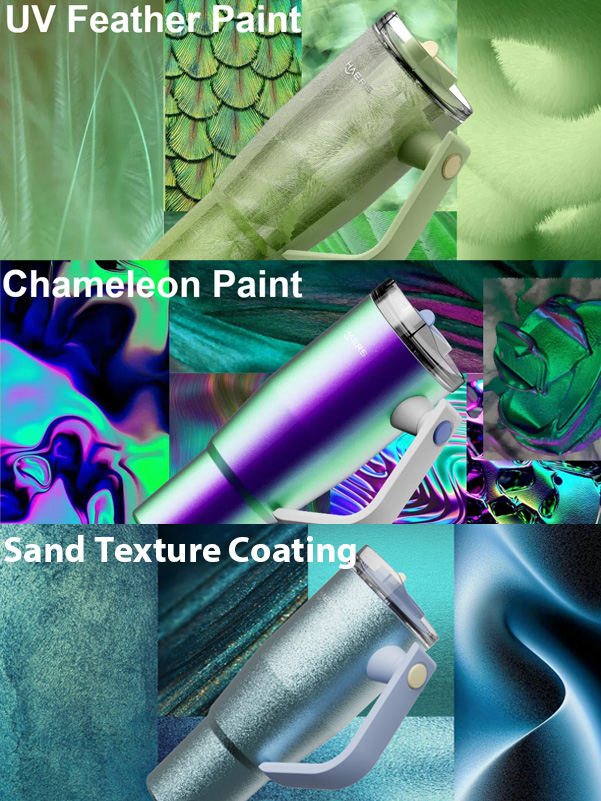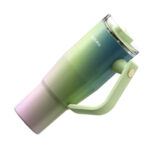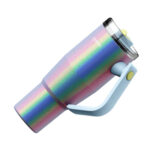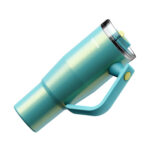Why 316 Stainless Steel Bottle is Expensive than 304 stainless bottles?
If you’ve ever shopped for a high-end insulated bottle or a baby bottle, you might have noticed the proud label: Made with 316 stainless steel. And you probably also noticed—it costs more. Whether in retail or bulk orders, 316 stainless steel bottles are always priced higher than those made with 304 stainless steel.
So, what makes 316 Stainless so special?
The secret lies in a tiny yet powerful ingredient: molybdenum (yep, it’s a tongue twister). Just adding 2–3% of this rare metal boosts corrosion resistance by more than 3 times! That’s why 316 stainless steel has become the go-to material for “picky” drinkware like baby bottles, custom coffee mugs, and premium thermal flasks where quality really matters.
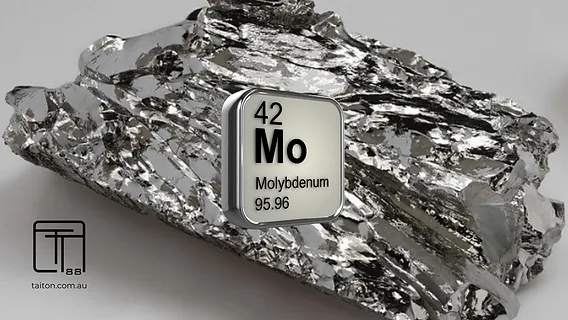
Table of Contents
ToggleWhat Is Molybdenum?
So, let’s talk about the real MVP behind 316 stainless steel’s performance—molybdenum (chemical symbol: Mo). It may sound like something out of a chemistry textbook, but this silvery-white metal plays a huge role in why 316 bottles outperform 304.
1. Superpowers in Physical Form
Molybdenum has one of the highest melting points of all metals—a scorching 2623°C, second only to tungsten. Even at 1000°C, it keeps almost 90% of its strength, while regular metals like iron drop to half their strength. That kind of heat resistance makes it a top choice in aerospace and military applications. When added to stainless steel, it helps bottles handle creatine water, steam sterilization, and rugged outdoor use like a champ.
2. A Natural Shield Against Corrosion
Molybdenum also forms a protective oxide layer called molybdenum trioxide (MoO₃). Think of it as a natural armor that resists rust—even in extremely acidic or salty environments. In fact, it resists corrosion 100 times better than iron, and can even survive in aqua regia (a chemical strong enough to dissolve gold!). That’s why 316 stainless steel is often used in custom drinkware for baby bottles, medical-grade flasks, or any container that holds sensitive or high-acid beverages.
3. Small in Quantity, Big in Impact
Here’s the kicker: molybdenum makes up just 0.001% of Earth’s crust. It’s mostly found in China, the U.S., and Chile, making it a strategic and rare resource. Only 2% to 3% is needed in a steel mix to dramatically upgrade durability, temperature tolerance, and corrosion resistance. That’s why it’s often called the “vitamin of the metal world”—a little bit goes a long way.
For manufacturers offering bulk or custom stainless steel bottles, using 316 stainless steel means tapping into the power of molybdenum to meet premium quality demands. Whether your customers care about health safety, outdoor durability, or daily sterilization, this metal brings peace of mind in every sip.
Why Is 316 More Expensive Than 304?
One major reason 316 stainless steel costs more than 304 is the addition of molybdenum, a rare and valuable element. Molybdenum is over ten times more expensive than chromium or nickel, and even though it’s only added in small amounts, it significantly increases the cost of the raw material.
But that’s not all. The production process for 316 is more demanding. It requires stricter temperature control, more refined alloy blending, and tighter quality assurance—especially important for custom water bottles or medical-grade applications. These extra steps ensure that 316 performs reliably in environments where 304 might fail.
And of course, rarity plays a role. Molybdenum is a strategic resource, mainly concentrated in a few countries like China, the U.S., and Chile. Limited supply and growing demand from aerospace, medical, and food-grade industries push up its market price.
So while the cost per unit may be higher, the value per use—especially in long-lasting bulk orders or high-trust industries—often outweighs the initial investment. You’re not just paying for steel; you’re paying for peace of mind, better safety, and long-term durability.
2% of Mo Changed the Game for Stainless Steel Bottles
Back in the 1960s, scientists made a fascinating discovery: adding just 2%–3% of molybdenum to stainless steel could dramatically boost its corrosion resistance in tough environments. That’s when 316 stainless steel was born—and it quickly became the gold standard for high-end insulated bottles, baby bottles, and custom drinkware.
The magic lies in the molybdenum content. Research shows that when molybdenum exceeds 2.2%, the metal’s corrosion resistance doesn’t just improve—it skyrockets. That’s exactly what the drinkware industry needed to safely hold acidic juices, salty water, and even herbal tonics.
1. Corrosion Resistance: Built Like a Shield
Stronger Protective Film: Molybdenum teams up with chromium and oxygen to form a dense protective oxide layer. Even though it’s half the thickness of a typical chromium oxide layer, it’s 40% harder. In acidic solutions (pH ~3), 316 stainless steel corrodes 66% less than 304, helping prevent harmful metal ions from leaching into your drink.
Stops Pitting and Crevice Corrosion: Chloride ions—like those found in sweat, tap water, or sports drinks—can eat away at regular stainless steel, creating tiny corrosion holes called “pits.” But in 316, molybdenum releases electrons that block this process. Its pitting resistance temperature is 20°C higher than 304’s, meaning it can safely hold saltwater, carbonated drinks, or electrolyte solutions without damage.
2. High Temperature, No Problem
Oxidation Control Under Heat: During high-temp steam sterilization (around 120°C), molybdenum slows down oxidation, keeping surface tarnish at bay. In tests, 316 gains 50% less weight from oxidation than 304, staying shiny and rust-free even after repeated disinfecting.
Improved Manufacturing Performance: Molybdenum also enhances the metal’s structure. In the producing process, 316 stainless steel resists cracking during stretching and pressing, reducing defect rates by up to 40%. This ensures even wall thickness—especially important for double-wall vacuum bottles to maintain reliable insulation.
3. All-Around Compatibility and Longevity
Acid and Alkali Friendly: Whether it’s espresso or traditional Chinese herbal drinks, 316 handles both acidic and alkaline liquids with ease. That’s why it’s preferred for custom tumblers targeting diverse beverage cultures and needs.
Self-Healing Surface: Accidentally scratch or bump your bottle? No worries. Molybdenum reacts with air and water to quickly rebuild the protective layer, repairing itself 3 times faster than steel without molybdenum. That means longer product life and fewer returns or complaints in your supply chain.
Here’s the chemistry behind the durability:
- Nickel keeps the steel’s structure stable,
- Chromium builds the basic protective layer,
- And molybdenum fills the gaps—especially in weak spots like weld seams and corners.
This “three-in-one” alloy synergy gives 316 its edge. And at 2%–3% molybdenum, manufacturers get the perfect balance of performance and cost, making it the go-to material for premium wholesale tumblers.
Where 316 Stainless Steel Truly Shines
In today’s drinkware world, 316 stainless steel has moved beyond lab tests and metal charts—it has become a trusted material across industries that demand higher standards. Thanks to the power of molybdenum, it’s not just steel; it’s smart protection designed for real-life challenges.
Take high-end insulated bottles, for example. Beverages like coffee and tea contain acids—like chlorogenic and tannic acids—that can cause mild corrosion over time. But 316 stainless steel resists these reactions remarkably well. Even after soaking in 60°C coffee for 24 hours, it releases just 0.01 mg/L of metal ions—far below the national safety limit. That means no metallic aftertaste, just a clean, flavorful drink. It’s the same story with carbonated drinks and electrolyte powders: while CO₂ and chloride ions can wear down standard steel, 316 maintains its integrity and keeps flavors pure.
In the mother and baby category, performance matters even more. Baby formula contains sensitive ingredients like lactoferrin and vitamin C, which can degrade in contact with reactive materials. 316 stainless steel not only resists this kind of corrosion, but its protective layer remains stable even after repeated high-temperature sterilization. That’s why many premium custom children’s bottles and food containers rely on it. Hospitals use it too—for surgical drain containers and disinfection tanks—because it’s one of the only stainless steels that can pass medical-grade safety standards, even when exposed to strong oxidizers like iodine and alcohol.
Outdoor and business scenarios also benefit from 316’s resilience. Whether you’re hiking in the rain or relaxing by the salty ocean breeze, a well-made 316 bottle can outlast 304 stainless by two to three years. In the office, it quietly proves its worth by resisting mineral buildup and discoloration, even when filled with herbal tea or traditional medicine. After months of use, the interior stays clean and smooth—no heavy scrubbing required.
At Haers, we’ve spent years mastering the art of stainless steel bottle manufacturing. We understand how to bring out the full potential of 316, from sourcing the right materials to precision forming and vacuum sealing. Choosing Haers isn’t just buying a bottle—it’s investing in market confidence, long-term performance, and customer trust. In a world full of options, a 316 stainless steel bottle made with care and molybdenum is more than just a product. It’s the reliable, high-margin favorite on your shelf—the one your customers will reach for again and again.




